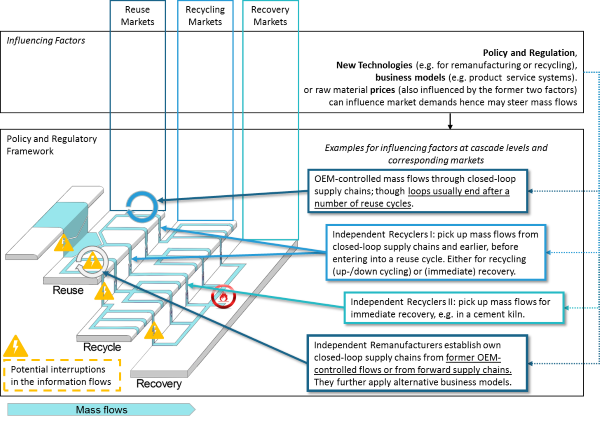Cascade Use decision making
Cascade Use decision making
The Cascade Use research group aims to provide support for informed decision making in the context of cascade use. Cascade use or cascade utilization is a term that stems from the biomass domain. Cascade utilization processes the different biomass components through cascades of reuse, recycling, and recovery (final sink). Process path are not fixed, inputs can go directly to recycling or recovery. However, in many cases it is desirable from an environmental perspective to maintain biomass products at the reuse or recycling levels of the cascade. The research group adopts the cascade utilization approach from the biomass domain to other products and materials (e.g. metals). In addition to the adoption of the cascade utilization concept, the research group further investigates how existing management approaches as well as the given landscape of software for end-of-life management (e.g. waste management, production planning and control, etc.) and databases on end-of-life products (e.g. IDIS, or company or network specific databases) can effectively support cascade use and thereby the idea of a circular economy.
Cascade Use Methodology
We support ways to rethink common perceptions of end-of-life management. With the adoption of the cascade utilization, we want to provide alternative perspectives on the end-of-life that ultimately result in different management practice. Many existing perspectives on the management of product lifecycles consider rather integrated types of organizations that manage iterative lifecycles. However, our research shows that market-oriented and independent organizations make use of the end-of-life too, and that these organizational types exist together with integrated organizations. Therefore, we developed the cascade use methodology, which considers the complexity of potential cascades at the end-of-life in a product lifecycle model. The following Figure “illustrates the emergence of a complex system rather than a clear, single SC process” when considering the real-world complexity at the end-of-life. “The cascade use methodology considers a complex system with various external influences that connects various SCs at certain stages and in certain points of the PLC. These selective connections throughout the cascade may stem from ‘leakages’ of one CLSC that take a different route than the CLSC through the cascades; or the connections consist of SCs deriving from a forward oriented SC. The integrated management of both CLSCs and forward SCs may end at a higher level of the cascade.” (Quotes from Kalverkamp et al, 2017).
Fig.: Examples for different influencing factors affecting cascade use mass flows (own figure)
(Kalverkamp et al, 2017, provided under a Creative Commons license)
Software and Databases
Product lifecycles have various stakeholders in addition to the product producer (i.e. the OEM). As indicated above various rather independent types of organizations may be present at the end-of-life or take advantage of end-of-life products and materials. In addition, political and other societal stakeholders may be present. All those stakeholders may be interested in material and resource efficiency of product lifecycles, though potentially with different motivations.
The Cascade research group Use is especially interested in third-party actors that are involved in reuse, recycling and waste management (the latter only when it connects with reuse or recycling). Those third parties are particularly challenged by limited data on products and by additional data management challenges. Dispersed and different types of suppliers, and interrupted information flows characterize the conditions for the supply chain management of those third parties. Such conditions re the reasons for additional data management challenges. We therefore investigate the database and software landscape for reuse and recycling (waste management), this currently includes a more general analysis of available software offerings in relation to enterprise resource planning (ERP) solutions and a detailed analysis of solutions in relation to supplier relationship management of independent actors in the reverse supply chain of automotive remanufacturing.




